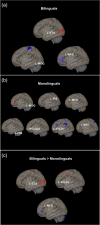Functional neuroanatomy of English word reading in early bilingual and monolingual adults
- PMID: 35607841
- PMCID: PMC9435003
- DOI: 10.1002/hbm.25955
Functional neuroanatomy of English word reading in early bilingual and monolingual adults
Abstract
Skilled reading is important in daily life. While the understanding of the neurofunctional organization of this uniquely human skill has advanced significantly, it does not take into consideration the common bilingual experiences around the world. To examine the role of early bilingualism on the neural substrates supporting English word processing, we compared brain activity, as well as functional connectivity, in Spanish-English early bilingual adults (N = 25) and English monolingual adults (N = 33) during single-word processing. Activation analysis revealed no significant differences between the two groups. A seed-to-voxel analysis using eight a priori selected seed-regions (placed in regions known to be involved in reading) revealed relatively stronger functional connectivity in bilinguals between two sets of regions: left superior temporal gyrus seed positively with left lingual gyrus and left middle frontal gyrus seed negatively with left anterior cingulate cortex. Together these results suggest that an early Spanish-English bilingual experience does not modulate local brain activity for English word reading. It does, however, have some influence on the functional intercommunication between brain regions during reading, specifically in two regions associated with reading, which are functionally connected to those inside and outside of the reading network. We conclude that brain regions involved in processing English words are not that different in Spanish-English early bilingual adults relative to monolingual adult users of English.
Keywords: English word processing; bilingualism; biliteracy; brain activity; functional connectivity; reading.
© 2022 The Authors. Human Brain Mapping published by Wiley Periodicals LLC.
Conflict of interest statement
The authors declare that they have no competing financial interests or commercial considerations and that this material has not been published (nor is it under consideration for publication) elsewhere.
Figures


References
-
- Abutalebi, D. J. , & Green, D. W. (2008). Control mechanisms in bilingual language production: Neural evidence from language switching studies. Language and Cognitive Processes, 23(4), 557–582. 10.1080/01690960801920602 - DOI
-
- Allman, B. (2005). Vocabulary size and accuracy of monolingual and bilingual preschool. ISB4: Proceedings of the 4th International Symposium on Bilingualism, ed. JamesCohen, Kara T. McAlister, Kellie Rolstad, and Jeff MacSwan, Somerville, MA: Cascadilla Press Children, 21, 58–77.
Publication types
MeSH terms
Grants and funding
LinkOut - more resources
Full Text Sources

